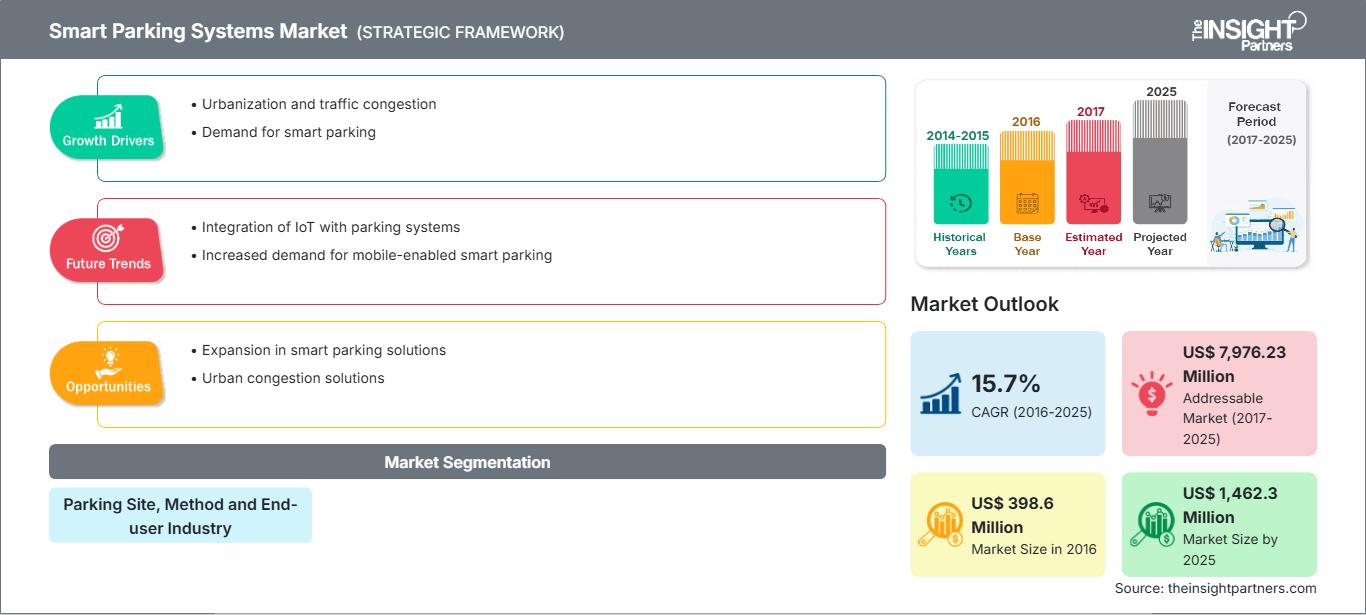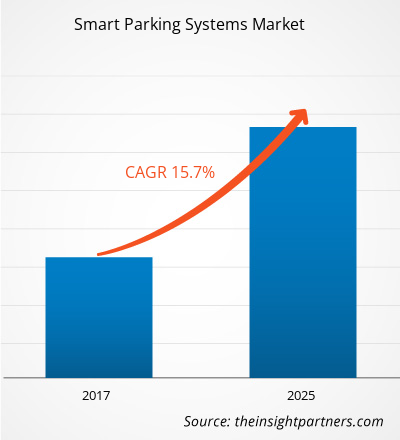Der Markt für intelligente Parksysteme wurde 2016 auf 398,6 Millionen US-Dollar geschätzt und soll bis 2025 1.462,3 Millionen US-Dollar erreichen; für den Zeitraum 2017–2025 wird ein durchschnittliches jährliches Wachstum von 15,7 % erwartet.
Parken ist ein schwieriges Thema, insbesondere im Stadtgebiet, wo 30–40 % aller Verkehrsstaus hauptsächlich auf die Parkplatzsuche der Autofahrer zurückzuführen sind. Die steigende Zahl der Fahrzeuge auf den Straßen, die immer größer werdenden Fahrzeuge im Luxussegment und die abnehmenden verfügbaren Parkplätze tragen zu Verkehrsstaus bei und machen sie weltweit zu einem alarmierenden Problem. Auch die begrenzte Verfügbarkeit von Daten, die für die Entscheidungen der Autofahrer erforderlich sind, führt häufig zu viel Zeitverlust und verschärft so die Parkplatznot in städtischen Gebieten. Dies führt auch zu Umweltschäden wie einem Anstieg der Kohlendioxid-Emissionen, Lärmbelästigung und Bodenverschmutzung. Diese Parkprobleme wirken sich auch auf die Umsätze lokaler Unternehmen in städtischen Gebieten aus. Aufgrund fehlender geeigneter Parkplätze verlieren viele lokale Einzelhandelsgeschäfte große Mengen an Umsatz, was sich direkt erheblich auf ihre Einnahmen auswirkt.
Parken an sich ist eine riesige Branche mit einem weltweiten Umsatz von über 100 Milliarden US-Dollar, und der Markt für intelligente Parksysteme entwickelt sich zu einem attraktiven potenziellen Markt für etablierte und neue Parkanbieter. Der Markt für intelligente Parksysteme verzeichnet derzeit in mehreren entwickelten geografischen Regionen ein deutlich hohes Wachstum und wird in den kommenden Jahren auch in anderen Regionen weltweit exponentiell wachsen.
Markteinblicke – Markt für intelligente Parksysteme
Wachstum bei der Implementierung von IoT-basierten Smart-City-Programmen
Eine Smart City nutzt die Leistungsfähigkeit der Technologie, um Prozesse effizient und reibungslos abzuwickeln, und macht intelligente Parksysteme zu einem wichtigen Bestandteil ihres Rahmens. Intelligente Technologie verfügt über das erhebliche Potenzial, die wichtigsten Vermögenswerte ihrer Kunden zu maximieren und eine verantwortungsvolle Entwicklung zu ermöglichen, indem sie für mehr Effizienz und Umsatzwachstum sorgt und so zu einer nachhaltigen Zukunft beiträgt. Die folgende Grafik zeigt den Anteil der Investitionen in verschiedene wichtige Aspekte von Smart Cities, wobei intelligente Transportsysteme ein deutliches Wachstum aufweisen. Parken ist das Hauptanliegen des modernen Transportsektors und wird in den kommenden Jahren voraussichtlich stark an Bedeutung gewinnen. Einer der hilfreichsten Aspekte einer Smart City ist der Einsatz von Technologie zur Entlastung von Verkehr und Parkproblemen.
Einblicke in das Segment Parkplätze
Basierend auf den Parkplätzen ist der Markt für intelligente Parksysteme in Parkplätze abseits der Straße und auf der Straße unterteilt. Beim Parken auf der Straße werden Fahrzeuge direkt am Straßenrand abgestellt und größtenteils von staatlichen Stellen kontrolliert. Beim Parken abseits der Straße hingegen werden Fahrzeuge in Garagen oder speziellen Parkbereichen abgestellt und von kommerziellen Stellen kontrolliert.
Einblicke in das Segment Komponenten
Intelligente/intelligente Parksysteme bestehen hauptsächlich aus zwei Elementen: Hardware und Software. Um das reibungslose Funktionieren dieser beiden Elemente zu unterstützen, werden entsprechende Dienste angeboten. In dieser Studie haben wir den Markt für intelligente Parksysteme in drei Komponenten segmentiert: Hardware, Software und Dienstleistungen. Der Gesamtumsatz des globalen Marktes für intelligente Parksysteme setzt sich aus den kumulierten Umsätzen dieser drei Komponenten zusammen.
Einblicke in die Segmente der Endverbraucherbranchen
Basierend auf den Endverbraucherbranchen ist der Markt für intelligente Parksysteme in Verkehrseinrichtungen, Behörden und Kommunen, gewerbliche Einrichtungen und Unternehmen segmentiert. Flughäfen in den Verkehrseinrichtungen leisten den größten Beitrag zum Markt für intelligente Parksysteme. Aufgrund des hohen Kundenaufkommens an solchen Orten hat die Verwaltung von Parkplätzen Priorität, weshalb Verkehrseinrichtungen den größten Marktanteil erobern. Allerdings führen Regierungsbehörden auch die Einführung intelligenter Parksysteme für öffentliche Parkplätze wie Parkplätze am Straßenrand und in öffentlichen Parkhäusern ein.
Passen Sie diesen Bericht Ihren Anforderungen an
Sie erhalten kostenlos Anpassungen an jedem Bericht, einschließlich Teilen dieses Berichts oder einer Analyse auf Länderebene, eines Excel-Datenpakets sowie tolle Angebote und Rabatte für Start-ups und Universitäten.
Markt für intelligente Parksysteme: Strategische Einblicke

- Holen Sie sich die wichtigsten Markttrends aus diesem Bericht.Dieses KOSTENLOSE Beispiel umfasst Datenanalysen, die von Markttrends bis hin zu Schätzungen und Prognosen reichen.
Sie erhalten kostenlos Anpassungen an jedem Bericht, einschließlich Teilen dieses Berichts oder einer Analyse auf Länderebene, eines Excel-Datenpakets sowie tolle Angebote und Rabatte für Start-ups und Universitäten.
Markt für intelligente Parksysteme: Strategische Einblicke

- Holen Sie sich die wichtigsten Markttrends aus diesem Bericht.Dieses KOSTENLOSE Beispiel umfasst Datenanalysen, die von Markttrends bis hin zu Schätzungen und Prognosen reichen.
Die Marktteilnehmer konzentrieren sich auf Produktinnovationen und -entwicklungen, indem sie fortschrittliche Technologien und Funktionen in ihre Produkte integrieren, um mit der Konkurrenz mithalten zu können.
2017: Amano Mcgann weitete seine Partnerschaft mit einem seiner ältesten Händler, PSX, auf Colorado aus.2017: Valeo und Cisco gaben eine Kooperationsvereinbarung zur Entwicklung strategischer Innovationen im Bereich intelligenter Mobilitätsdienste bekannt.2017: Smart Parking gab bekannt, dass es einen neuen Auftrag in Neuseeland gewonnen hat und von Wilson Parking New Zealand als bevorzugter Lieferant von Sensor- und Parkbuchtentechnologie an neun neuen Standorten ausgewählt wurde.2017: Smart Parking brachte sein neu entwickeltes SmartSpot IoT Gateway auf den Markt, mit neuen und verbesserten Funktionen, die an die Anforderungen von Smart Cities angepasst sind.
Regionale Einblicke in den Markt für intelligente Parksysteme
Die Analysten von The Insight Partners haben die regionalen Trends und Faktoren, die den Markt für intelligente Parksysteme im Prognosezeitraum beeinflussen, ausführlich erläutert. In diesem Abschnitt werden auch die Marktsegmente und die geografische Lage in Nordamerika, Europa, dem asiatisch-pazifischen Raum, dem Nahen Osten und Afrika sowie Süd- und Mittelamerika erörtert.
Umfang des Marktberichts zu intelligenten Parksystemen
| Berichtsattribut | Einzelheiten |
|---|---|
| Marktgröße in 2016 | US$ 398.6 Million |
| Marktgröße nach 2025 | US$ 1,462.3 Million |
| Globale CAGR (2016 - 2025) | 15.7% |
| Historische Daten | 2014-2015 |
| Prognosezeitraum | 2017-2025 |
| Abgedeckte Segmente |
By Parkplatz, Methode und Endverbraucherindustrie |
| Abgedeckte Regionen und Länder | Nordamerika
|
| Marktführer und wichtige Unternehmensprofile |
|
Dichte der Marktteilnehmer für intelligente Parksysteme: Verständnis ihrer Auswirkungen auf die Geschäftsdynamik
Der Markt für intelligente Parksysteme wächst rasant. Die steigende Nachfrage der Endnutzer ist auf Faktoren wie veränderte Verbraucherpräferenzen, technologische Fortschritte und ein stärkeres Bewusstsein für die Produktvorteile zurückzuführen. Mit der steigenden Nachfrage erweitern Unternehmen ihr Angebot, entwickeln Innovationen, um den Bedürfnissen der Verbraucher gerecht zu werden, und nutzen neue Trends, was das Marktwachstum weiter ankurbelt.

- Holen Sie sich die Markt für intelligente Parksysteme Übersicht der wichtigsten Akteure
Der globale Markt für intelligente Parksysteme ist wie folgt segmentiert:
Markt für intelligente Parksysteme – nach Parkplätzen
- Off-Street
- On-Street
Markt für intelligente Parksysteme – nach Fahrzeugtyp
- Hardware
- Software
- Dienste
Markt für intelligente Parksysteme – nach Endverbraucherbranchen
- Transporteinrichtungen
- Regierung und Kommunen
- Gewerbliche Einrichtungen
- Unternehmenseinrichtungen
Markt für intelligente Parksysteme – nach Geografie
Nordamerika
- USA
- Kanada
- Mexiko
Europa
- Frankreich
- Deutschland
- Italien
- Großbritannien
- Russland
- Rest von Europa
Asien-Pazifik (APAC)
- China
- Indien
- Südkorea
- Japan
- Rest von APAC
Naher Osten und Afrika (MEA)
- Südafrika
- Rest von MEA
Südamerika (SAM)
- Brasilien
- Argentinien
- Rest von SAM
Markt für intelligente Parksysteme – Unternehmensprofile
- Amano McGann, Inc.
- Cisco Systems, Inc.
- Kapsch
- Nedap NV
- Parkmobile, LLC
- Parkmobile, LLC
- Skidata AG
- Smart Parking Ltd.
- Swarco AG
- SWARCO AG
- Urbiotica
- Xerox Corp.
- Historische Analyse (2 Jahre), Basisjahr, Prognose (7 Jahre) mit CAGR
- PEST- und SWOT-Analyse
- Marktgröße Wert/Volumen – Global, Regional, Land
- Branchen- und Wettbewerbslandschaft
- Excel-Datensatz
Aktuelle Berichte
Erfahrungsberichte
Grund zum Kauf
- Fundierte Entscheidungsfindung
- Marktdynamik verstehen
- Wettbewerbsanalyse
- Kundeneinblicke
- Marktprognosen
- Risikominimierung
- Strategische Planung
- Investitionsbegründung
- Identifizierung neuer Märkte
- Verbesserung von Marketingstrategien
- Steigerung der Betriebseffizienz
- Anpassung an regulatorische Trends






















 Kostenlose Probe anfordern für - Markt für intelligente Parksysteme
Kostenlose Probe anfordern für - Markt für intelligente Parksysteme